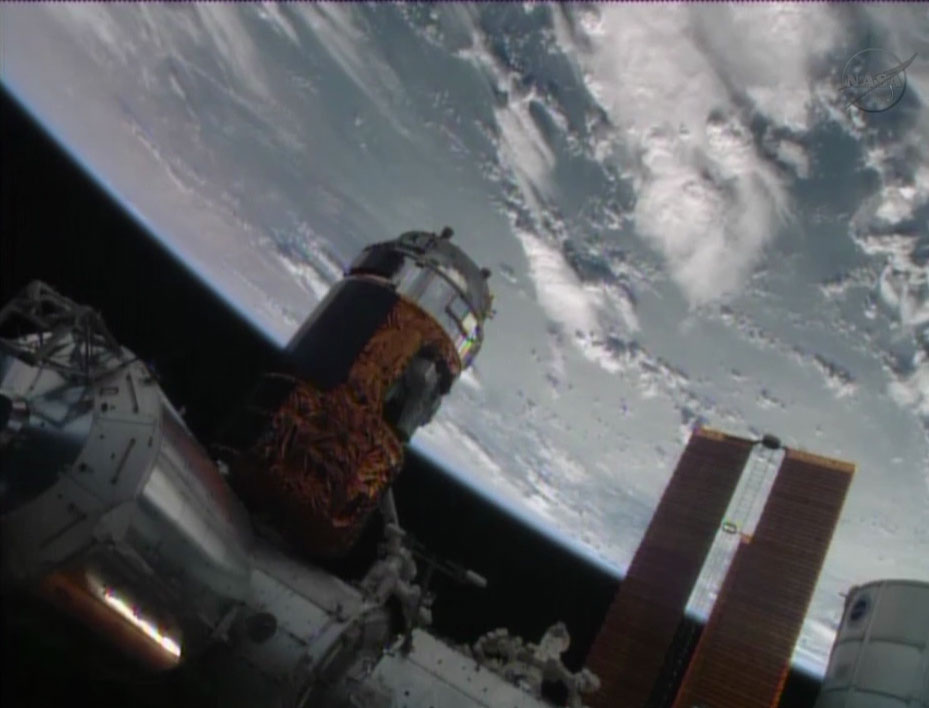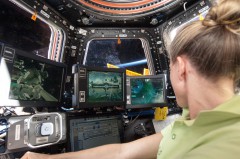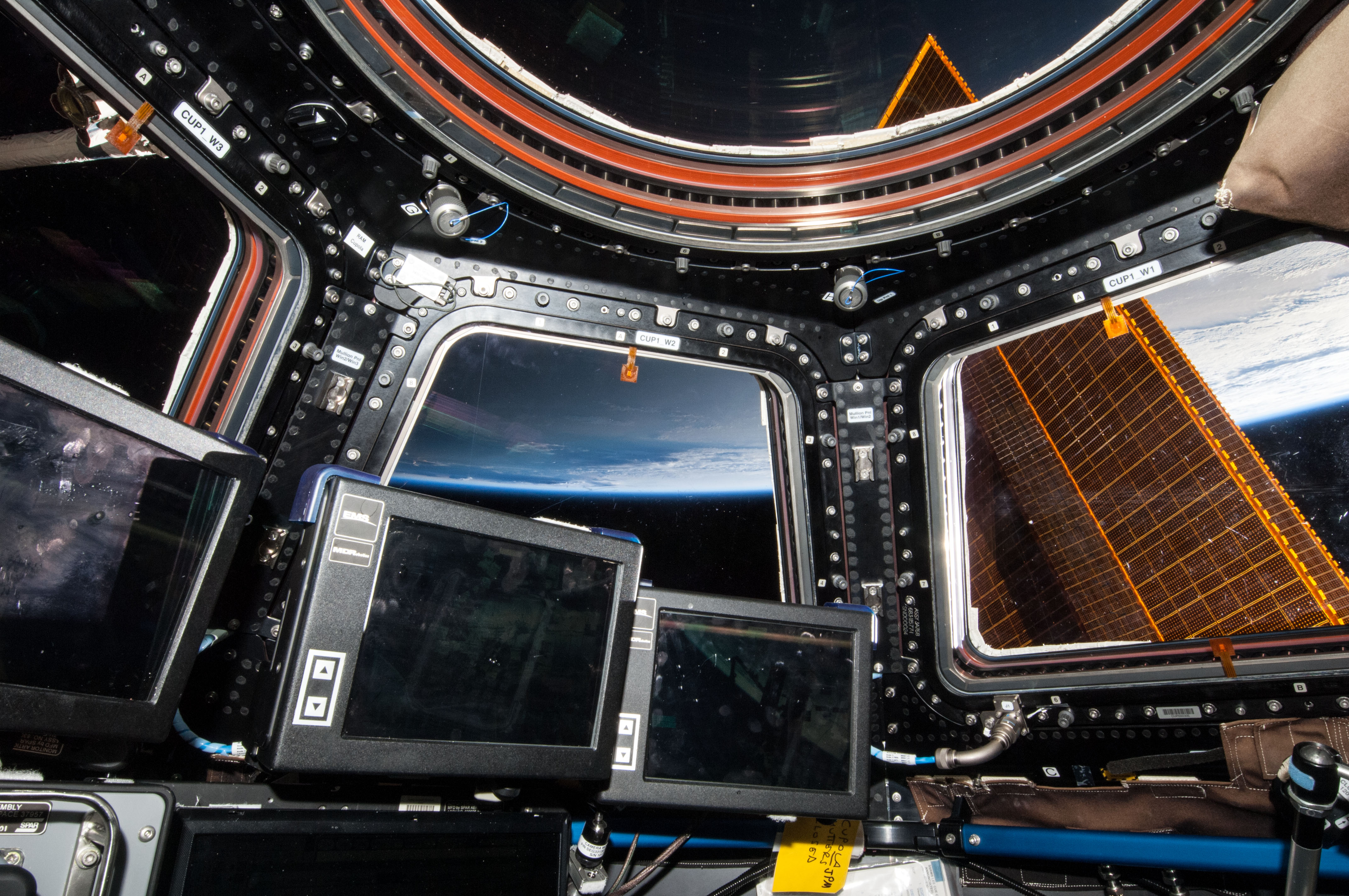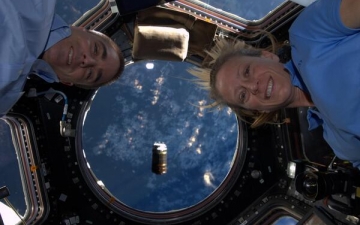
Six days after its screaming launch from the Tanegashima Space Center in southern Japan, the fourth H-II Transfer Vehicle (HTV-4) has arrived safely at the International Space Station, bringing more than 11,900 pounds of equipment, supplies, food, water, clothes, experiments, and a talking robot to the incumbent Expedition 36 crew. Nicknamed “Kounotori” (“White Stork” or “Oriental Stork”), early Friday the giant cargo craft approached autonomously to within 33 feet of the station, whereupon it was grappled by the 57-foot-long Canadarm2 robotic arm and berthed at the nadir (Earth-facing) port of the Harmony node. Hatches between the ISS and HTV-4 will be opened tomorrow (Saturday), preparatory to several intensive days of cargo removal and transfer.
At the controls of Canadarm2 for today’s busy activity were NASA astronauts Karen Nyberg and Chris Cassidy, whilst their Italian crewmate Luca Parmitano was responsible for monitoring the final stages of the approach and berthing. All three astronauts were based at the Robotic Work Station (RWS) and Hardware Command Panel (HCP) in the space station’s multi-windowed cupola. Backup support was provided by the RWS inside the U.S. Destiny laboratory. Nyberg accomplished the initial grapple of HTV-4’s Flight Releasable Grapple Fixture at 7:22 a.m. EDT, as the ISS orbited just to the south of South Africa. Over the next few hours, she steadily guided it into a “ready to latch” orientation over the Active Common Berthing Mechanism (ACBM) of the Harmony nadir port.

Nyberg and Cassidy employed a laptop computer to conduct the initial “first stage” capture of Harmony’s Active CBM with HTV-4’s Passive CBM, after which the ground team completed the bolting process through “second stage” capture. Four latches engaged to hold the Japanese craft in place and 16 bolts were driven to achieve the “hard mate,” which occurred at 11:38 a.m. EDT. Over the next few hours—quoting JAXA’s press kit—the astronauts will conduct “vestibule outfitting (e.g. installation of lines and cables), activation of HTV power supply from the ISS, [and] switching of the communications lines from wireless to wired communications.”
Early tomorrow (Saturday), Cassidy, Nyberg, and Parmitano will remove the Controller Panel Assemblies from the Active CBM, open the hatch, and enter HTV-4’s pressurized compartment. One of their first internal tasks will be to activate the Inter-Module Ventilation system and transfer portable fire extinguishers and breathing apparatus.
The arrival of HTV-4 will begin a four-week period of operations, during which about 11,900 pounds—about 5.4 metric tons—of payloads and supplies will be transferred. This includes 3.9 metric tons of pressurized cargo and 1.5 metric tons aboard HTV-4’s unpressurized segment.

Key payloads include the newly-developed Freezer-Refrigerator of Stirling Cycle (FROST) for the pressurized Kibo module, which will cool experimental samples to below -70 degrees Celsius, even in the case of power outages. The ISS Cryogenic Experiment Storage Box (ICEBox) will keep a container cool without electrical power, whilst a Re-entry Data Recorder (known as the “i-Ball”) will measure velocities, accelerations, temperatures, and imaging data during HTV-4’s fiery re-entry. The spacecraft’s unpressurized segment will house a replacement Main Bus Switching Unit (MBSU), a Utility Transfer Assembly (UTA), and NASA’s Space Test Program-Houston4 (STP-H4). Four small CubeSats—the PicoDragon, TechEdSat-3, ArduSat-1, and ArduSat-X—are also aboard, as is the “super-sensitive” 4K camera to observe Comet ISON and Japan’s unique “Kirobo” talking robot.
HTV-4’s Exposed Pallet (EP), to which all of its unpressurized payload is mounted, will be removed from the craft over the weekend by Canadarm2. It will then be “handed off” to the smaller robotic arm of the Japanese Kibo laboratory and attached to the porch-like Exposed Facility on the far-port side of the ISS. This includes NASA’s Space Test Payload-Houston4 (STP-H4)—a suite of seven experiments to investigate space communications, Earth monitoring, and materials science—whilst the older STP-H3 will be transferred back to HTV-4’s EP for eventual disposal in the upper atmosphere during re-entry.

On a more basic level of necessity, clothes, dried food, snacks, and beverages for the ISS crew, including 480 liters of water, will be aboard. Additionally, the Advanced Technology On-Orbit Test Instrument for Space Environment-mini (ATOTIE-mini) will fly for the first time to evaluate changes in surface potential of HTV-4 before and after berthing at the space station and if this potentially affects spacewalkers. The spacecraft will be loaded with trash at the end of its mission and will be unberthed on 5 September and deorbited two days later.
First flown in September 2009, the HTV measures over 30 feet long and 14 feet in diameter, weighs about 21,000 pounds, and can carry 13,000 pounds of payload to the space station. Its pressurized segment can house up to eight refrigerator-sized International Standard Payload Racks (ISPRs), which are transferred in a shirt-sleeve environment by the ISS crew, whilst an unpressurized segment enables external payloads to be robotically removed and installed onto the porch-like Exposed Facility of Japan’s Kibo laboratory. Like SpaceX’s Dragon, the HTV approaches the ISS and is captured and berthed to the Harmony node by means of the Canadarm2 robotic arm.
Unlike Dragon, the Japanese craft burns up in the atmosphere at the end of each mission, although JAXA has advanced plans for a HTV-R variant, with a “return” capsule to transport around 3,200 pounds of payload back to Earth. The first flight of the HTV-R is tentatively scheduled for 2018. Since its maiden voyage, a HTV mission has flown approximately every 12-18 months, delivering a wide range of payloads and experiments to the ISS, including the Hyperspectral Imager for the Coastal Ocean (HICO) instrument, a high-tech aquarium capable of supporting several generations of fish for up to three months, a Gradient Heating Furnace, and a number of small CubeSats.
Want to keep up-to-date with all things space? Be sure to “Like” AmericaSpace on Facebook and follow us on Twitter:@AmericaSpace




One Comment
One Ping
Pingback:Expedition 36 Crew Lands in Kazakhstan | Space Safety Magazine